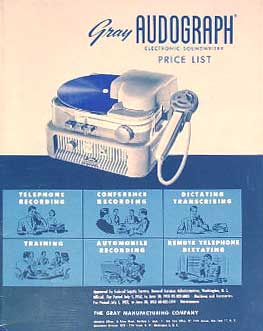
Mohawk Midgetape
The U.S. market for dictation equipment grew but competition became fierce in the 1950s. Electronics and the new media, particularly magnetic recording, made it possible for companies to offer new kinds of systems. Now, for example, the telephone could be used to “dial up” a central office dictator/transcriber. Typists accessed the machine remotely. The cost savings of these systems attracted many businesses that had resisted office dictation earlier.

Minifon (sold in the US under various brands)
Dictation equipment manufacturers targeted users at the very top of the corporate hierarchy– upper managers and executives–in part because they hoped that if they could convert the executives the rest of the organization would follow. But executives as a group were notorious for refusing to use the dictation machine. The Big Guys preferred to dictate to a personal secretary–who was very often an attractive young women. Execs also had the power to refuse to use technologies they didn’t like–and many of them didn’t like dictation machines. Many admitted to having “mike fright,” when the machine was turned on, or they preferred making notes in longhand and then dictating to their personal secretaries. But this was an expensive way to write letters, and dictation equipment marketers continued to remind them of this. However, there were some executives who had just the opposite attitude. These enthusiastic users created demand for a new type of business recorder that came along in the 1950s–the portable. In a day when “portable electronics” was virtually an unknown concept, the portable tape or wire recorder was to some the ultimate cool corporate accessory. Like laptops and cell phones in the 90s, a flashy, ultra-miniaturized recorder, bearing the all important “Transistorized” label, became something of an execu-fad. But like other dictation machines, user’s attitudes seemed to gravitate toward the poles– they either loved them or hated them. And it seemed like the majority of people felt self-conscious doing something like sitting on an airplane, talking into a little box. Nevertheless, a dozen or so miniaturized voice recorders appeared in the 1950s and early 1960s. Mohawk Business Machines (pictured above) was one of the pioneers in the early 1950s, but the real success stories were the recorders imported from Germany, Scandinavia, and Japan, like the “Minifon” (above).


